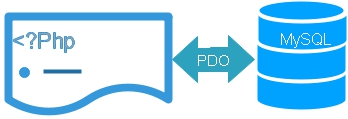PHP PDO Fetch row from Table
 WE often need to collect one record from the table to display or to use in our script. To select one record we will use Pdo -> fetch to get next row from a result set. Here are some examples on how to use fetch on different conditions.
WE often need to collect one record from the table to display or to use in our script. To select one record we will use Pdo -> fetch to get next row from a result set. Here are some examples on how to use fetch on different conditions.
We kept our Pdo database connection details in config.php file and called it here.

Without binding parameters
require "config.php"; // Database connection details.
$query="SELECT name FROM student WHERE id=5";
$row=$dbo->query($query);
$row=$row->fetch();
echo $row['name'];FETCH Modes
We will explore different retrieval modes from the result set associated with a PDOStatement object. The mode parameter determines how the fetched row is returned, specifying formats such as associative array, numeric array, object, or a combination of both. This flexibility allows developers to choose the most appropriate data structure for their needs.Check the code below on how to set default PDO Fetch mode attribute.
FETCH_OBJ
In most of the cases we have to use variables inside our query. The safe way ( to prevent injection attack ) is to use prepared statements where we pass the data separately.<?Php
error_reporting(E_ERROR | E_PARSE | E_CORE_ERROR);
require "config.php"; // Database connection details.
//////// End of Database connection /////////
$id='3'; // Collecting one record with id=3
$count=$dbo->prepare("select * from pdo_admin where id=:id");
$count->bindParam(":id",$id,PDO::PARAM_INT,1);
if($count->execute()){
echo " Success <br>";
$row = $count->fetch(PDO::FETCH_OBJ);
print_r($row);
echo "<hr><br>Admin = $row->userid";
echo "<br> pw =$row->password<br>";
echo "<hr>";
}else{
//$row=$count->fetchAll();
print_r($dbo->errorInfo());
}
?>
( [id] => 3 [userid] => admin3 [password] => test3 [name] => Admin [status] => T )
Admin = admin3
pw =test3WE have used FETCH_OBJ parameter get property name corresponding to column name. Same way we will try other parameters In your downloaded script ( file name : pdo-fetch.php ) the area to change the part of the code is marked. You can replace them with these lines to check the output
FETCH_NUM
We have to use column number starting from 0 in place of column name , omitted other lines and listed here the changes in above code.$row = $count->fetch(PDO::FETCH_NUM);
print_r($row);
echo "<hr>";
echo "<br>Admin id = $row[0]";
echo "<br>userid = $row[1]";
echo "<br>password=$row[2]<br>";Array ( [0] => 3 [1] => admin3 [2] => test3 [3] => Admin [4] => T )
Admin id = 3
userid = admin3
password=test3FETCH_ASSOC
Returned array will have column name ( field name ) as index. Here is the code$row = $count->fetch(PDO::FETCH_ASSOC);
print_r($row);
echo "<hr>";
echo "<br>Admin id = $row[id]";
echo "<br>userid = $row[userid]";
echo "<br>password=$row[password]<br>";Array ( [id] => 3 [userid] => admin3 [password] => test3 [name] => Admin [status] => T )
Admin id = 3
userid = admin3
password=test3FETCH_BOTH
Returns both column name ( field name ) and number index ( starting from 0 ) in the array.$row = $count->fetch(PDO::FETCH_BOTH);
print_r($row);
echo "<hr>";
echo "<br>Admin id = $row[0]";
echo "<br>userid = $row[userid]";
echo "<br>password=$row[2]<br>";Array ( [id] => 3 [0] => 3 [userid] => admin3 [1] => admin3 [password] => test3 [2] => test3 [name] => Admin [3] => Admin [status] => T [4] => T )
Admin id = 3
userid = admin3
password=test3FETCH_LAZY
This returns both FETCH_OBJ and FETCH_BOTH, code is here$row = $count->fetch(PDO::FETCH_LAZY);
print_r($row);
echo "<hr>";
echo "<br>Admin id = $row[0]";
echo "<br>userid = $row[userid]";
echo "<br>password=$row->password<br>";How to set PDO attribute for default fetch mode
Default setting is FETCH_ASSOC. We can change this any other fetch type.$id='1'; // Collecting one record with id=1
$dbo->setAttribute(PDO::ATTR_DEFAULT_FETCH_MODE, PDO::FETCH_OBJ);
$count=$dbo->prepare("SELECT * FROM student where id=:id");
$count->bindParam(":id",$id,PDO::PARAM_INT,3);
if($count->execute()){
$row = $count->fetch(); // Now, it fetches as an object
echo "Name = $row->name"; // Accessing as object
}else{
print_r($dbo->errorInfo());
}$dbo->setAttribute(PDO::ATTR_DEFAULT_FETCH_MODE, PDO::FETCH_NUM);
// Other lines remain same as above.
echo "Name = $row[1]"; // Accessing numerically indexed arraySUMMARY : PDO Fetch Modes and their Use Cases
1. PDO::FETCH_ASSOC
Returns results as an associative array where column names are keys. Use when you want to access data by column name for readability.
$stmt = $pdo->query("SELECT * FROM users");
while ($row = $stmt->fetch(PDO::FETCH_ASSOC)) {
print_r($row);
}
2. PDO::FETCH_NUM
Returns results as an indexed array, useful for memory optimization or when working with column numbers.
$stmt = $pdo->query("SELECT * FROM users");
while ($row = $stmt->fetch(PDO::FETCH_NUM)) {
print_r($row);
}
3. PDO::FETCH_OBJ
Returns rows as objects, ideal for object-oriented programming where accessing fields like properties is needed.
$stmt = $pdo->query("SELECT * FROM users");
while ($row = $stmt->fetch(PDO::FETCH_OBJ)) {
echo $row->name;
}
4. PDO::FETCH_BOTH
Returns both an indexed array and associative array. Use this when you need flexible access to both column numbers and names.
$stmt = $pdo->query("SELECT * FROM users");
while ($row = $stmt->fetch(PDO::FETCH_BOTH)) {
print_r($row);
}
5. PDO::FETCH_CLASS
Fetches data into an instance of a specified class, great for custom data structures.
class User {
public $name;
}
$stmt = $pdo->query("SELECT * FROM users");
$stmt->setFetchMode(PDO::FETCH_CLASS, 'User');
while ($row = $stmt->fetch()) {
echo $row->name;
}
Sample Student table SQL dump
PDO References Collecting multiple records by using parameterized queries

Subhendu Mohapatra
Author
🎥 Join me live on YouTubePassionate about coding and teaching, I publish practical tutorials on PHP, Python, JavaScript, SQL, and web development. My goal is to make learning simple, engaging, and project‑oriented with real examples and source code.
Subscribe to our YouTube Channel here

| Plusco | 03-10-2014 |
| These are great examples! Much appreciated. | |
| sachin baghel | 13-11-2018 |
| Brilliant explaination. | |
